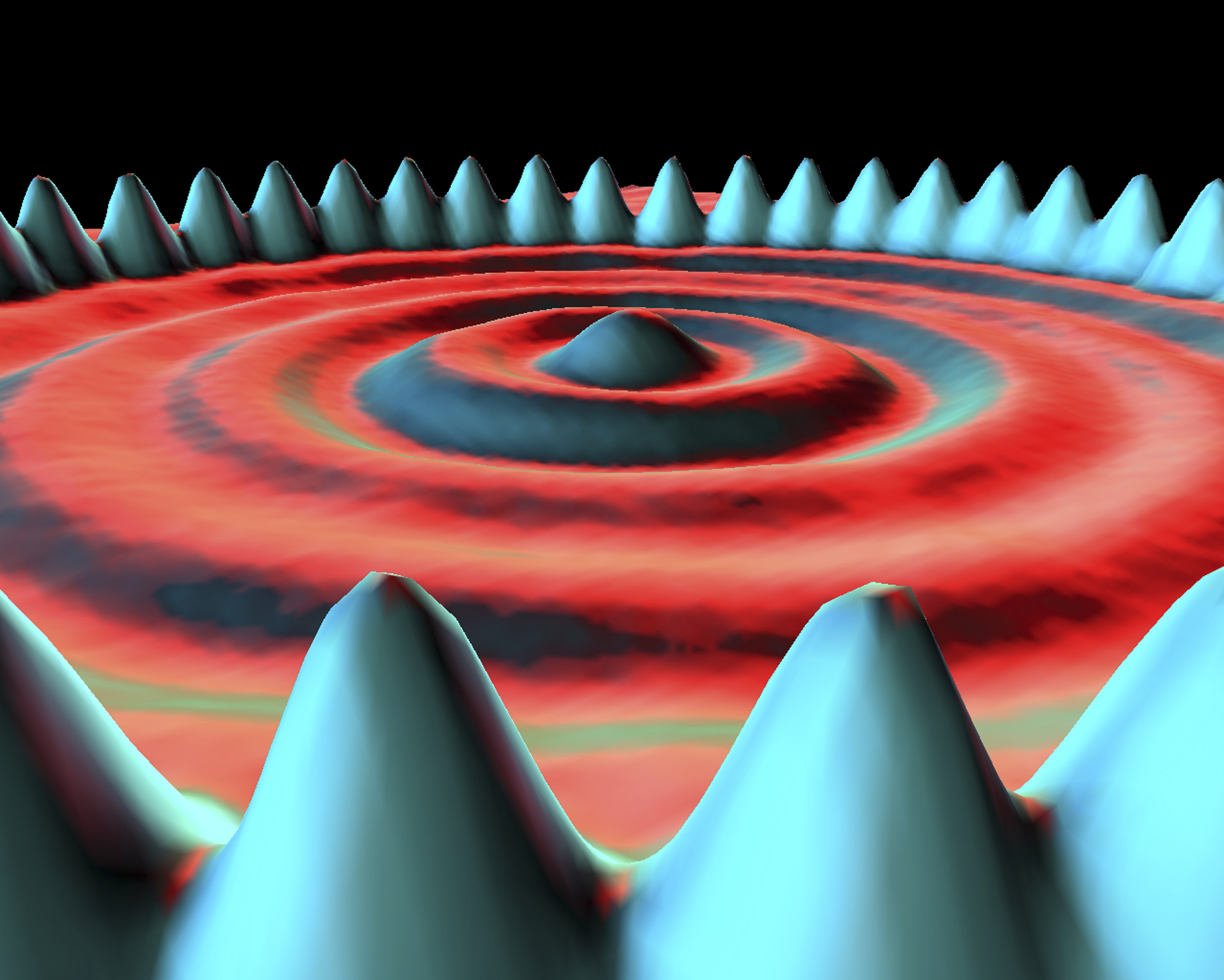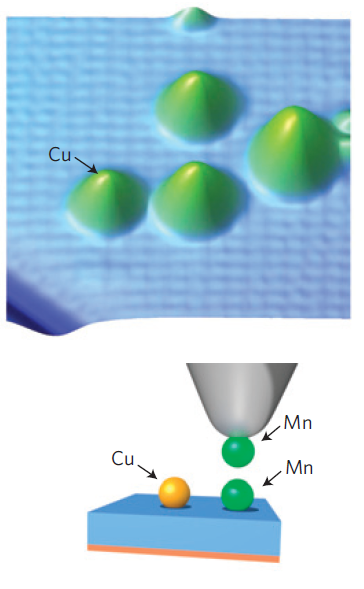Scanning tunnelling microscopes (STM) are a wonderful instruments that can not only image but also manipulate individual atoms on a surface. Developed by Gerd Binning and Heinrich Rohrer in 1981, STM and their derivatives revolutionized our understanding of what happens on the surface of materials.

The famous quantum corral, fabricated and imaged in 1993 by Don Eigler at IBM. Atoms (blue) are placed on a circle and consequently modify the electron density on the surface (red ripples). (c) IBM
Expanding on Binning and Rohrer’s work at IBM in Zurich, Don Eigler at IBM’s Almaden lab in particular pioneered the modification of individual atoms on a surface. In 1989 he famously accomplished moving atoms on a surface to form the letters IBM. For these accomplishments Eigler received this year’s Kavli Prize in Nanoscience.
IBM continues to pioneer STM research at Almaden. The group of Andreas Heinrich, for example, who started at IBM in 1998 as a postdoc with Don Eigler, is working on the study of magnetic atoms. He and Eigler have now accomplished another major advance in microscopy technology. So far, STM measurements were mainly static and little information of dynamic properties was available. In a study published in Science, they now have developed a method that is able to measure how long it takes for atoms to flip their electron spin. This technique opens the door to measurements of the dynamics of a number of properties, for example vibrational states.
In STMs a sharp tip (typically made from tungsten) is scanned across a surface at very small distances of only around a nanometer. At this close distance, an electric tunnelling current flows between the tip and the surface. This tunnelling current is strongly dependent on the distance to the surface, and as the tip is moved across the surface this current can be used to measure the topology with atomic precision.
To resolve the electronic spin of atoms on a surface, a slight modification of the STM tip is necessary. For this, the topmost atom on the tip is not made from non-magnetic tungsten, but from manganese. For this magnetic tip the tunnelling current depends on the relative orientation of the spins in manganese and the sample surface. If the orientation of the spin in manganese is opposite to that of an individual atom on the surface, no tunnelling current will flow. If they are aligned, a current will flow.

In an earlier Nature Physics paper, Andreas Heinrich showed how an electric pulse can control the electron spin of atoms. Image reprinted by permission from Macmillan Publishers Ltd: Nature Physics 6, 340 (2010).
In the experiment by Eigler and Heinrich iron-copper dimers (a copper and iron atom bound together) were studied. An external magnetic field is used to align the electronic spins of these dimers in the same direction, so that the system is in a well-defined, pre-determined state.
Previously, Heinrich has already demonstrated how a single voltage pulse applied by the tip can switch the spin of an atom on the surface in opposite direction to the external magnetic field. But as soon as the voltage signal from the tip stops the spin of the iron-copper dimer will switch back again, because of the force from external magnetic field.
This relaxation of the spin back to its original state has now been measured by Eigler and Heinrich. They measure the tunnel current after a short period of time after the initial pulse. Has the spin flipped back, the current will be different, because the orientation between the manganese atom’s spin on the tip and that of the dimer will have changed.
Of course, Heisenberg’s uncertainty principle forbids the precise measurement of position and momentum, and what one gets in a single experiment is very much a random information. Sometimes the spin has relaxed, sometimes not. Therefore, many hundreds of thousands of switching experiments are done at various time delays. When averaged, what we see is in an exponential decay curve in tunnel current over time that is a measure of the average spin relaxation time back to the original state. For iron-copper dimers, spin relaxation times between 5 and 250 ns were measured.
The method used here is rather general, and will allow similar experiments on a number of different systems. In particular, the dynamics of any system that shows a variation in tunnelling current depending on experimental parameters is a possibility. An example mentioned in the paper are vibrational excitations of molecules.
Over the past years, STM has become much more than an instrument that can take pretty pictures of static atoms and molecules. Indeed, with this study the tunnelling microscope has entered the dynamic, time-resolved domain.
Reference:
Loth, S., Etzkorn, M., Lutz, C., Eigler, D., & Heinrich, A. (2010). Measurement of Fast Electron Spin Relaxation Times with Atomic Resolution Science, 329 (5999), 1628-1630 DOI: 10.1126/science.1191688


Trackbacks/Pingbacks
[…] actually, we’ve come across Andreas Heinrich’s previous research before, he does very innovative research with scanning tunneling microscopes (STM). In this latest […]